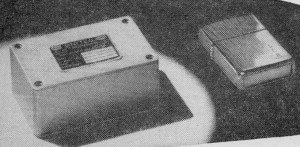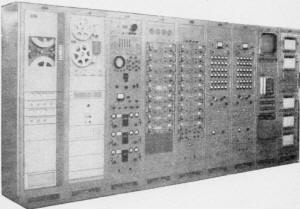November 1959 Popular Electronics
 Table
of Contents Table
of Contents
Wax nostalgic about and learn from the history of early electronics. See articles
from
Popular Electronics,
published October 1954 - April 1985. All copyrights are hereby acknowledged.
|
Telemetering - the remote
sensing and reporting of system parameters via radio link - was just coming of age
in the late 1950s when this article appeared in Popular Electronics magazine.
It was the age of space payload rocket development (as opposed to artillery and
fireworks rockets), high speed jet airliners, and the Pioneer 1 space probe.
There was a great need to collect data during the developmental and operational
engineering project stages in order to ascertain causes for failures when they occurred
and to know what went right when success triumphed. A pinnacle of the newborn telemetering
era was Pioneer 1, which
carried an image scanning infrared television system to study the Moon's surface
to a resolution of 0.5 degrees, an ionization chamber to measure radiation in space,
a diaphragm/microphone assembly to detect micrometeorites, a spin-coil magnetometer
to measure magnetic fields to 5 microgauss, and temperature-variable resistors to
record the spacecraft's internal conditions*. Unfortunately, the launching rocket
experienced a malfunction that buggered the flight trajectory, but the craft still
managed to return some useful data. In that instance engineers benefitted from both
success and failure telemetering.
Telemetering - Vital Link to the Stars


Of little importance until recently, telemetering is now one
of the latest-growing fields in electronics.
By Earl Stowell
A 100-ton 85·foot missile fights its way up into the sky, arches proudly out over
the ocean, falters, veers wildly, becomes a surging spectacle of flame, then plunges
into the ocean. After the scientists recover from their disappointment, how can
they find out what caused the failure? The answer is telemetering - the process
of taking measurements at one place and simultaneously sending them to another place
for interpretation or "read-out."
Telemetering should not be confused with remote control. When you set the temperature
control of a modern stove, you are using a type of remote control to regulate the
oven temperature. But if the stove has a signal lamp that goes on when the correct
temperature is reached, this is a form of telemetering - because information (the
temperature) is measured at one place and is then sent to another for "read-out."
Sending Back the News

Telemetering components are always compactly packaged. Above
is a transistorized subcarrier oscillator made by United Electrodynamics.

A Parsons crystal-controlled two-watt FM transmitter.

A telemetering r.f. amplifier. This Rheem unit covers 215 to
245 mc.

Ground installation is last link in telemetering chain. High-gain
antennas, such as the 60' "dish" above by Radiation, Inc., feed signals into elaborate
electronic "brains."

First two racks of Parsons ground system contain tape recording
equipment; in the third rack are receivers and test equipment; the next two hold
bandpass filters and discriminators; racks 7 and 8 are demodulators and patch-panel
racks; the next-to-last one contains oscilloscope and associated equipment; rack
at far right holds five strip recorders.
Only in recent years has there been a need for telemetering. In the early days
of flying, for example, when planes were much simpler than they are now, a test
pilot would take a new plane up for its initial run and would then report back to
the designers what changes should be made. But nowadays things happen so fast on
test flights that it's impossible for the pilot to notice everything that's going
on. And today's aircraft are so expensive and complex that if an accident occurs,
a method of determining the reason for the accident is essential. Telemetering provides
the means for solving these very real and important problems.
Weather-study instruments developed in the Thirties provided a clue for the design
of telemetering equipment. A German scientist devised a simple but effective system
for determining atmospheric conditions at various altitudes. He attached a battery-powered
radio transmitter to a balloon and then hooked up some sensing elements to it that
delivered varying voltages in proportion to altitude, temperature, and humidity.
As the balloon floated through the sky, a three-point rotating switch connected
each of the instruments in turn to the transmitter. Even today, this simple technique
forms the basis of many telemetering systems.
Instrumentation
Telemetering systems seem complicated, but their complexity comes from the amount
of detail involved, rather than from their inherent circuit complications.
The first links in a telemetering chain are the measuring instruments, which
are designed to produce output voltages in ratio to their readings. For instance,
to measure temperature between 0° and 100°, a measuring instrument with an output
range from 0 to 5 volts would deliver no output at 0° and 5 volts at 100°. A temperature
of 50° would result in an output of 2.5 volts. It is more common, however, to use
a measuring instrument that puts out ±2.5 volts, with zero representing half-scale;
hence, -2.5 volts would indicate a temperature of 0° and +2.5 volts would mean 100°.
These voltage variations from the measuring instruments must be coded before
they are fed into a transmitter. For example, information can be indicated by varying
the duration of the pulse; this method is called PDM (Pulse Duration Modulation).
Or the amplitude of the pulse might be varied (PAM, or Pulse Amplitude Modulation).
Another method is PCM (Pulse Code Modulation) or its close relative PPM (Pulse Position
Modulation) in which the position of two short pulses with relation to each other
is the code.
For extreme accuracies, a digital system is used. In this system, each measurement
is changed to a binary number which may then be handled with high accuracy - up
to 0.01% if required - and the output can be fed directly into a digital computer.
Final Link
At the ground station, specially designed antennas pick up the r.f. signals which
are demodulated, sorted out, and turned into understandable form. In some cases,
the signals are decoded as fast as they are received; this is called "real-time"
telemetering. Most of the information is recorded by tape recorders for later study.
Some advanced telemetering systems feed selected information directly into computers
for immediate processing, as mentioned above, making it possible to notify a pilot
of danger developing before he is aware of its presence.
Because telemetering installations are usually tailored to a particular job,
there are as many telemetering systems as there are engineers with imaginations.
But if you know the general principles involved, you will be able to understand
any telemetering system with a little study.
Problem and Solution
Let's take a typical telemetering problem and then follow through on its solution.
Assume that we want to send up a missile for testing. Since it's doubtful that the
missile will return to the ground in one piece, we must get the information we need
while the missile is in flight. Suppose we want to know its angle of flight, speed,
yaw and pitch rates, the level of gamma rays encountered by the missile, and various
other measurable data.
Now, how do we get this information? We start by building a battery-powered FM
transmitter into the missile. Then, if we have many measurements to send back to
the ground, we can use a combination of two frequency-saving methods of feeding
the transmitter.
First, we use subcarrier oscillators to create multiplex subchannels. Some systems
use up to 18 subchannels - all of which can be handled by the same transmitter.
For instance, if the first subcarrier oscillator (SCO 1) has a center frequency
of 400 cps, a ±2.5-volt input signal from the sensing element will cause SCO 1 to
vary from 370 to 430 cps. Accordingly, SCO 18 has a center frequency of 70 kc.,
and its output frequency will vary from 64.75 to 75.25 mc.
The outputs from the SCO's all modulate the FM transmitter simultaneously and
the receiver on the ground sorts out and decodes the different SCO frequencies.
Secondly, one or more SCO's can perform multiple service by means of a simple
mechanical" system. A rotating switch with multiple contacts can be wired up to
connect several sensing elements to a single SCO one at a time. As a small external
motor rotates the switch, each sensing element is sampled in order. See block diagram
on page 43.

Block diagram of typical telemetering system. Subcarrier oscillators
all modulate transmitter simultaneously. SCO 4 does multiple duty by sampling four
different measurements in order when commutator turns.

Cross section of telemetering pay load carried by the "Pioneer
I." Although short-lived, the "Pioneer I" provided a great deal of data.
In the event that the missile should be recovered intact, it's a wise precaution
to include a small tape recorder in the airborne system. Should the transmitter
go off the air for any reason, the recorded tape would be vitally important.
Expensive but Economical
Although telemetering systems are fairly expensive, in our rocket projects they
more than pay their way. Telemetering makes each test flight - no matter how apparently
disastrous - at least partially successful. Design weaknesses can be analyzed long
after the flight is over, and troubles can be ironed out before another test is
attempted.
In industry, too, telemetering pulls its own weight. Recently, a major airframe
company spent two million dollars for telemetering equipment to be used in testing
jet transport planes. The saving in test time will easily pay for the system.
Telemetering offers a rapidly growing field to those who like something new and
exciting. To the rest of us, it promises safer flying and information which will
speed our conquest of outer space.

Posted January 25, 2023
(updated from original
post on 2/17/2013)
|





































